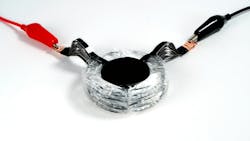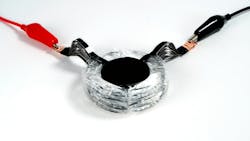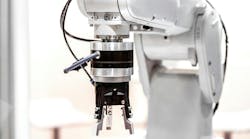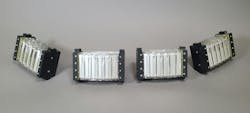Soft Electrohydraulics Improve Actuation Technology for Robotics
The emerging field of soft robotics requires the use of materials which are soft, flexible and stretchable. Artimus Robotics has developed an actuation technology to help meet this requirement known as HASEL which stands for hydraulically amplified self-healing electrostatics.
Soft robotics aims to provide more human-like performance through the use of soft and flexible materials. This enables a robot to be adaptable, lighter weight, and easier to integrate into applications like wearables such as exoskeletons or medical devices.
“The limitation of soft robotics is they're mostly relying on pneumatic actuators and some traditional hydraulic actuators where you're tethered to a pump and some valves to control the flow of fluid in and out of those soft robots,” explained Eric Acome, Ph.D., CEO and Co-Founder of Artimus Robotics. “That's difficult to control, adds to the overall size of the system, and reduces speed and efficiency.”
So as part of his Ph.D. research at the University of Colorado Bolder, Acome and a team of researchers set out to overcome the limitations of traditional actuator technologies, leading to development of the HASEL actuators. Artimus Robotics is a spin-off company from these research efforts which is working to bring this technology to the market.
What is a Hydraulically Amplified Self-Healing Electrostatic Actuator?
According to Acome, the HASEL technology uses flexible materials and electrostatics to generate motion as opposed to traditional electromagnetics. “There are some benefits to that,” he said. “Electromagnetics require high current [whereas] HASEL and other electrostatic actuators use very low current so they can be much more efficient in certain applications.”
He explained that HASEL is comprised of three main components:
- flexible polymer pouch
- dielectric liquid and
- electrodes.
The pouch is made up of thin plastic films, similar to a ketchup packet said Acome, and filled with the dielectric liquid — meaning it is insulating and does not conduct electricity. Electrodes are placed on either side of the pouch to pump fluid into the pouch.
“When you apply a high electric field across the electrodes, you get those electrostatic forces which pumps the fluid within the pouch and you can get some change in shape of the structure,” he explained. “We're directly pumping fluid within a flexible pouch to get change of motion, to get actuation.”
This design allows for a lot of different capabilities. “We can make actuators that contract very much like muscle, actuators that expand, and couple them to other structures to get more complex types of motion,” said Acome.
See the HASEL actuator's motion capabilities in action by watching the below video from Artimus Robotics.
He went on to say that because HASEL utilizes entirely flexible, non-metal materials and electrostatics, when the actuator is activated and holding position it does not consume much power. This can benefit use in a mobile application where it is necessary to conserve energy. “If it's an application where a robot needs to move to a position and hold its state, or is intermittent, it's going to be more efficient than something that's directly driven by a motor.”
While you could have a hydraulic or pneumatic cylinder to perform actuation in these applications, those components are typically made of metal and therefore heavy as well as require other componentry such as valves and pump which can make their use in soft robotics less desirable.
Read the below articles to learn more about how pneumatics are utilized in various robotics applications.
“We're great for applications where you need something that's really lightweight and can be very efficient,” said Acome. “Another benefit is that we get direct motion by changing the electrical signal to the actuator and directly turn that into motion. It simplifies the overall system and gives you a little bit better control.”
How Hydraulics Come into Play with the HASEL Actuators
Acome explained that Artimus Robotics refers to HASEL as a soft or flexible electrohydraulic actuator. This is because electrostatic forces are being directly applied to the dielectric liquid and motion is achieved by pumping that liquid.
“We’re taking electricity and turning it directly into hydraulic pressure,” he said.
He noted that it is possible to scale the force and displacement output as well as other performance aspects by changing the size of the electrodes which is why the company refers to it as an electrohydraulic technology. But they are careful to make a distinction from more traditional and rigid hydraulic actuators by using the terms soft or flexible in conjunction with electrohydraulic.
HASEL Actuators Can Benefit Broad Range of Applications
While the HASEL actuators are an emerging technology, Acome sees them benefiting a range of applications. Where the company is currently seeing the most traction currently are those applications in which the actuators are able to meet not only performance requirements but also specific environmental challenges or overcome the limitations of traditional actuation technology.
An example Acome gave is the work Artimus Robotics is doing with the Office of Naval Research on projects exploring how these actuators can be used in the ocean. The deep ocean in particular is a challenging environment because of the high pressures experienced underwater as well as the corrosive nature of saltwater.
He said HASEL actuators are suited to such environments because they have a simpler design with fewer parts and are tolerant of high pressures.
Another use case he sees for the HASEL actuators is within MRI (magnetic resonance imaging) machines as it removes the presence of metal components and electromagnetics which can distort images due to the magnetic fields created by these machines.
Smaller scale applications such as miniature robotics, consumer electronics and haptics where small actuators are commonly utilized could also employ the HASEL actuators. Acome said electric motors and other traditional actuator technologies are typically not as efficient when scaled down to a smaller size but the HASEL actuators “actually tend to perform better at a smaller scale.”
The actuators can also be used to assist with conveying, gripping, and other industrial applications, offering a fast and controllable actuation option.
Watch Artimus Robotics' video below to see how the HASEL actuator can benefit industrial applications such as food production.
With growing interest in humanoid robots, the HASEL actuators could also aid the design of more dexterous grippers that are capable of moving similarly to a human hand, though Acome said that will require more development. The human hand has 27 degrees of freedom which he said means you would need 27 actuators integrated into a gripper to get similar performance for a humanoid robot.
“Today, most humanoid robots…don't have hands on them or the hands have limited degrees of freedom,” he said.
Part of the reason for this is because the more actuators you install, the more componentry required. If using an electric motor-based system, for instance, it will be necessary to also incorporate several lead screws. And if it is a hydraulics-based system, a lot of valves and other components are required. As the number of components increases, so too does the weight and cost of that robotic implement.
In addition, Acome said traditional actuation systems are prone to overheating and they are noisy. “We see a big opportunity for our technology to replace traditional actuators and enable humanoid robots with a high level of dexterity by creating hands that have many degrees of freedom, that are lightweight and that are lower cost because the system is simpler and more energy efficient.”
He noted that because the HASEL actuators are not drawing current they do not heat up like other solutions might.
“But that's an application which is really demanding, so that's an area where we're trying really hard to improve the performance of the actuators to meet the demands of it.”
The HASEL actuator technology is still in the early stages with Acome noting it is not being used at scale in any applications yet. But Artimus Robotics has a few key customers it is working with to improve feasibility and performance. This will hopefully lead to larger pilot projects in the next couple of years to prove out the actuator’s value when used in the field and eventually be scaled up for use by those key customers and in other future applications.
About the Author
Sara Jensen
Executive Editor, Power & Motion
Sara Jensen is executive editor of Power & Motion, directing expanded coverage into the modern fluid power space, as well as mechatronic and smart technologies. She has over 15 years of publishing experience. Prior to Power & Motion she spent 11 years with a trade publication for engineers of heavy-duty equipment, the last 3 of which were as the editor and brand lead. Over the course of her time in the B2B industry, Sara has gained an extensive knowledge of various heavy-duty equipment industries — including construction, agriculture, mining and on-road trucks —along with the systems and market trends which impact them such as fluid power and electronic motion control technologies.
You can follow Sara and Power & Motion via the following social media handles:
X (formerly Twitter): @TechnlgyEditor and @PowerMotionTech
LinkedIn: @SaraJensen and @Power&Motion
Facebook: @PowerMotionTech

Leaders relevant to this article:





